Maintaining a healthy and active lifestyle is crucial for our overall well-being. Regular exercise keeps our bodies fit and plays a vital role in preventing and managing various health conditions. Physiotherapists specializing in physical rehabilitation and movement recommend specific exercises to improve strength, flexibility, and posture while reducing pain and discomfort. By following these exercises recommended by physiotherapist and incorporating these exercises into your program, you will get healthy soon.

Squats help in muscle and bone development
When you visit a physio centre, squirting is the most common exercise that you will do. Squats are excellent exercises that work multiple muscle groups, including the glutes, quadriceps, and hamstrings. Assume a stance with your feet positioned at a distance equal to the width of your shoulders, bend your knees, and drop the hips like you are resting on a rocking chair. Ensure that the knees belonging to you do not extend beyond your toes. Hold the position for a few seconds, then slowly rise back up. Start with a few repetitions and gradually increase as you build strength.
Physiotherapists encourage planks exercise for strong hips and core muscles
Planks are fantastic for strengthening the core muscles, including the abdominals, lower back, and hips. Begin by lying face down on the floor, then lift your body onto your forearms and toes. Maintain your posture straight, activating the muscles in your entire body, starting from the top of your head down to your feet, while focusing on engaging your core. Maintain the posture for as long as possible, aiming for 30 seconds to a minute. As you progress, increase the duration gradually.
Shoulder Rotations are highly recommended for physiological exercises
Shoulder rotations are beneficial for improving shoulder mobility and reducing stiffness. Stand straight with your arms relaxed by your sides. Slowly raise your arms to the sides and rotate them forward in small circles. Complete 10 circles, then reverse the direction for another 10 circles. Take it slow and focus on maintaining proper form throughout the exercise.
A bridge helps in improving the core muscles
The bridge exercise targets the glutes, lower back, and core muscles. Lie flat on your back with your knees bent and walk bare on the floor. Place your arms by your sides. Raise your hip on the floor until your body forms a straight line from the knees to your shoulders. Hold the position for a few seconds, then slowly drop the hips. Do it again, several repetitions, gradually increasing the intensity.
Hamstring Stretches help in increasing mobility
Tight hamstrings can lead to discomfort in your back and limited mobility. To stretch your hamstrings, sit on the edge of a chair with one leg extended in front of you. Keep your back straight and gently lean forward, feeling the stretch in the back of your thigh. Hold for 30 seconds, then switch legs. Repeat the stretch a few times on each leg.
Wall Push-Ups are important physiotherapy exercise
Wall push-ups are great for strengthening the chest, shoulders, and arms. Stand facing a wall and place your palms on the wall at shoulder height. Step back slightly, keeping your body straight. Bend your elbows, lower your chest toward the wall, and then push to the initial position. Perform it several times, gradually increasing the number as you gain strength.
Incorporating these exercises into your fitness routine can help improve your overall strength, flexibility, and mobility. However, consulting with a physiotherapist or healthcare professional before starting any new exercise program is important, especially if you have any underlying health conditions or injuries.
Remember to start slowly and observe your body movements. If you experience pain or discomfort during any exercise, stop immediately and seek guidance from a professional. By following physiotherapists’ recommendations and incorporating these exercises into your program, you can take a proactive approach to your health and well-being. Stay active, stay healthy!


